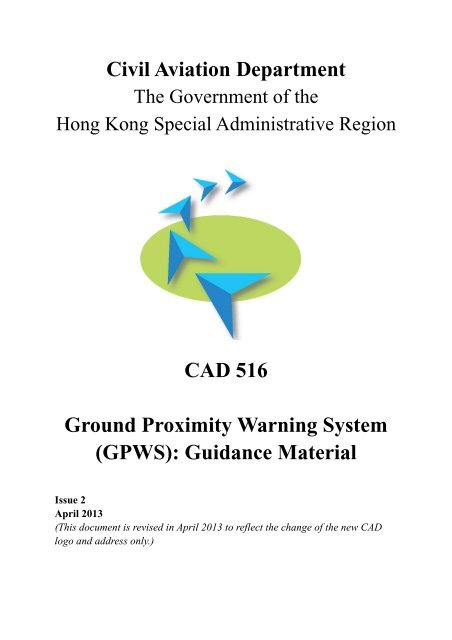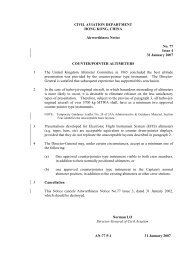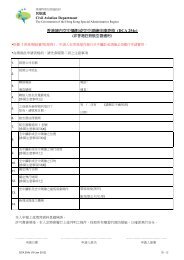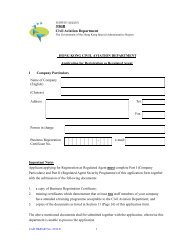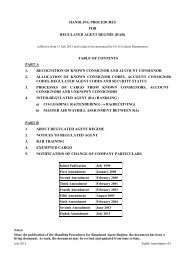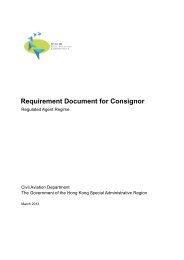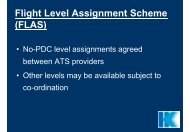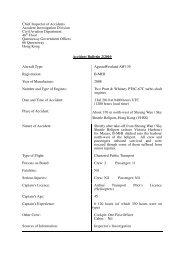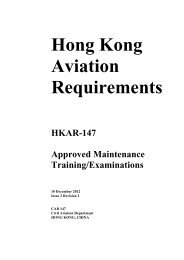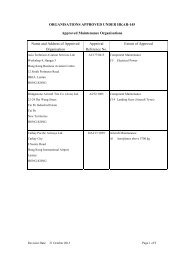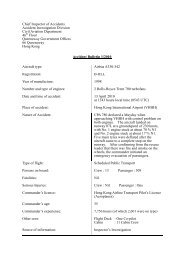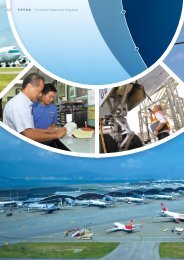CAD 516 Ground Proximity Warning System
CAD 516 Ground Proximity Warning System
CAD 516 Ground Proximity Warning System
Create successful ePaper yourself
Turn your PDF publications into a flip-book with our unique Google optimized e-Paper software.
Civil Aviation Department<br />
The Government of the<br />
Hong Kong Special Administrative Region<br />
<strong>CAD</strong> <strong>516</strong><br />
<strong>Ground</strong> <strong>Proximity</strong> <strong>Warning</strong> <strong>System</strong><br />
(GPWS): Guidance Material<br />
Issue 2<br />
April 2013<br />
(This document is revised in April 2013 to reflect the change of the new <strong>CAD</strong><br />
logo and address only.)
Intentionally Left Blank<br />
June 2001 ii Issue 1
<strong>CAD</strong> <strong>516</strong><br />
GROUND PROXIMITY WARNING<br />
SYSTEM (GPWS):<br />
GUIDANCE MATERIAL<br />
Civil Aviation Department<br />
Hong Kong, China<br />
iii
Intentionally Left Blank<br />
June 2001 iv Issue 1
Contents<br />
Section<br />
Page<br />
1. PURPOSE.....................................................................................................................1<br />
2. DEFINITIONS .............................................................................................................1<br />
2.1 Alert ...................................................................................................................1<br />
2.2 Basic GPWS.......................................................................................................1<br />
2.3 Predictive GPWS ...............................................................................................1<br />
2.4 Standard GPWS .................................................................................................2<br />
2.5 <strong>Warning</strong>..............................................................................................................2<br />
2.6 Types of <strong>Warning</strong>s..............................................................................................2<br />
3. GENERAL....................................................................................................................3<br />
4. PREDICTIVE GROUND PROXIMITY WARNING SYSTEMS...........................3<br />
5. EXAMPLES OF LIMITATIONS OF CURRENT GPWS EQUIPMENT .............5<br />
5.1 Reduced Effectiveness .......................................................................................5<br />
5.2 Unwanted <strong>Warning</strong>s...........................................................................................6<br />
5.3 Other Limitations...............................................................................................7<br />
6. OPERATIONS MANUALS AND CHECK LISTS...................................................7<br />
7. TRAINING .................................................................................................................10<br />
8. ACTION TO BE TAKEN ON RECEIVING ALERTS AND WARNINGS..........11<br />
8.1 Basic GPWS.....................................................................................................11<br />
8.2 Standard and Predictive GPWS .......................................................................13<br />
8.3 Discretion - Basic, Standard and Predictive GPWS equipment ......................17<br />
9. REPORTING AND FOLLOW-UP OF GPWS ALERTS AND WARNINGS.......18<br />
9.1 General.............................................................................................................18<br />
9.2 Reporting..........................................................................................................18<br />
9.3 Follow-up Action .............................................................................................20<br />
Issue 1 v June 2001
Intentionally Left Blank<br />
June 2001 vi Issue 1
1. PURPOSE<br />
The purpose of this publication is to provide to all concerned in the operation of<br />
aeroplanes information on, and guidance in the use of, ground proximity warning<br />
systems (GPWS). Legislation regarding the requirement to carry GPWS is to be<br />
found in the Air Navigation (Hong Kong) Order 1995. In compliance with ICAO<br />
Standards, Airworthiness Directives are issued from time to time which amplify the<br />
Order and set out amendments to regulatory requirements as equipment performance<br />
advances and as changes in aviation safety-related needs are identified.<br />
This document includes information on the different categories of alerts or warnings<br />
which may be encountered in flight, together with advice concerning the appropriate<br />
flight crew response to each case. The various modes of protection afforded by the<br />
equipment are described. However, details of the operating envelopes of the systems<br />
are set out in manufacturers’ handbooks or company Operations Manuals which<br />
should be studied by all personnel involved in the operation of aeroplanes equipped<br />
with GPWS. Information is also presented recommending the details which should<br />
be included in Checklists, Operations and Training Manuals.<br />
2. DEFINITIONS<br />
2.1 Alert<br />
A caution generated by the GPWS equipment.<br />
2.2 Basic GPWS<br />
A GPWS system which gives no indication of the mode triggered other than Mode 5.<br />
2.3 Predictive GPWS<br />
A GPWS system which contains a facility to enable the prediction of loss of required<br />
terrain clearance ahead of the aircraft and the generation of associated warnings.<br />
Issue 1 1 June 2001
2.4 Standard GPWS<br />
A GPWS system which has no terrain-predictive function.<br />
2.5 <strong>Warning</strong><br />
A command generated by the GPWS equipment.<br />
2.6 Types of <strong>Warning</strong>s<br />
2.6.1 Genuine<br />
The equipment provides a warning in accordance with its technical<br />
specification<br />
2.6.2 Nuisance<br />
The equipment provides a warning in accordance with its technical<br />
specification, but the pilot is flying an accepted safe procedure.<br />
2.6.3 False<br />
A fault or failure in the system causes the equipment to provide a warning that<br />
is not in accordance with its technical specification.<br />
NOTE: 'Unwanted' may be used to described both nuisance and false.<br />
June 2001 2 Issue 1
3. GENERAL<br />
3.1 GPWS enhances safety. It is not a foolproof means of preventing collision with the<br />
ground. It can prevent some accidents, particularly those which could result from<br />
crew errors or distraction, inappropriate ATC instructions or navigation equipment<br />
malfunction. In sum, a timely alert or warning can be provided of unintentional<br />
closure with the ground.<br />
3.2 The response to all alerts or warnings should be positive and immediate – recognition<br />
and action. Establishing the cause of GPWS activation should take second place.<br />
3.3 There is a risk that repeated experience of unwanted warnings may so reduce crew<br />
confidence in the system that response to a warning in the real event may be less<br />
urgent than needed. Therefore flight crews should report all alerts and warnings to<br />
the operator, thereby ensuring that appropriate analysis or remedial action can be<br />
taken. The reports will form a basis on which GPWS performance can be monitored<br />
both by the operators and by the <strong>CAD</strong>. By this means, problems of general concern<br />
should be detected at an early stage, and allow action to be taken and necessary advice<br />
or information disseminated to all concerned without delay. Details of reporting and<br />
follow-up action for GPWS alerts and warnings are given at paragraph 9.<br />
4. PREDICTIVE GROUND PROXIMITY WARNING SYSTEMS<br />
4.1 In accordance with ICAO standards, the Hong Kong Civil Aviation Department<br />
requires that all Hong Kong registered aeroplanes first issued with a Certificate of<br />
Airworthiness on, or after, 1 January 2001 authorised for the carriage of 30 passengers<br />
or more, or with a certificated take-off mass in excess of 15,000 kgs, carry GPWS<br />
equipment with predictive terrain capability.<br />
This requirement will be extended to all such aircraft for compliance by 1 January<br />
2003.<br />
Issue 1 3 June 2001
4.2 In addition to the standard GPWS features, Terrain Awareness and <strong>Warning</strong> <strong>System</strong><br />
(TAWS) provides:<br />
(a)<br />
A forward-looking terrain avoidance function which gives look-ahead terrain<br />
and obstacle protection along and below the aeroplane’s lateral and vertical<br />
flight path.<br />
(b)<br />
Premature descent alert function that detects when the aircraft is hazardously<br />
below the normal approach path to the nearest runway and provides a timely<br />
alert.<br />
4.3 One manufacturer’s solution to this ICAO requirement is the development of TAWS.<br />
The predictive function is achieved by feeding the aeroplane’s known position, as<br />
determined by a Flight Management <strong>System</strong> (FMS) or by a Global Position <strong>System</strong><br />
(GPS), to a terrain database, enabling the computer to predict terrain ahead and to the<br />
side of the aeroplane’s flight path. Terrain features can then be displayed to the<br />
flight crew. TAWS therefore overcomes shortcomings associated with GPWS in that<br />
it produces earlier alerts and warnings of significant terrain that lie ahead at all stages<br />
of flight. Furthermore, with reference to terrain around an airfield, it can warn of<br />
descent below safe vertical profiles when the aircraft is in a landing configuration and<br />
where no ILS glideslope is present.<br />
4.4 TAWS, which has been in use for some time, describes only one solution to the<br />
requirement for terrain prediction. Other solutions are now in the course of<br />
development or in production. A second solution – Enhanced GPWS (EGPWS) – is<br />
also in service and a third – Terrain Awareness and Display (TAD) – is also available.<br />
June 2001 4 Issue 1
5. EXAMPLES OF LIMITATIONS OF CURRENT GPWS EQUIPMENT<br />
5.1 Reduced Effectiveness<br />
5.1.1 As basic or standard GPWS (non-predictive) equipment does not look ahead,<br />
any warning when flight is towards high terrain ahead of the aircraft will be<br />
minimal and dependent upon the steepness of the ground. Hence a sheer cliff<br />
ahead of the aircraft will not generate any warning and any subsequent<br />
warning due to rising ground beyond the cliff will be delayed until the aircraft<br />
is over that ground.<br />
5.1.2 Alerts and warnings are triggered in Modes 1 and 2, only when the aircraft is<br />
below 2500 feet above local terrain. The maximum time in these modes<br />
between triggering an alert or warning and contact with the ground if no<br />
corrective action is taken, is of the order of 20 seconds. However, this time<br />
will be reduced if excessive rates of descent exist or there is rising ground<br />
beneath the aircraft.<br />
5.1.3 Cessation of a Mode 2 warning means only that the aircraft has cleared the<br />
terrain beneath it. There may still be rising terrain ahead of the aircraft.<br />
5.1.4 Flight crew should be aware that, with standard GPWS equipment, if the<br />
aircraft is fully configured for landing, in the absence of electronic glideslope<br />
information, a normal rate of descent to the surface short of a runway will not<br />
trigger any alert or warning.<br />
Issue 1 5 June 2001
5.2 Unwanted <strong>Warning</strong>s<br />
CAUTION:<br />
WHERE ANY DOUBT EXISTS THAT THE SAFETY OF THE AIRCRAFT MAY<br />
BE IN JEOPARDY, THE CREW MUST TAKE ACTION AS PRESCRIBED IN THIS<br />
DOCUMENT RELATING TO GPWS ALERTS AND WARNINGS.<br />
5.2.1 Occasionally under certain normal and safe operating conditions an alert or<br />
warning may occur due to a combination of descent rate and rising ground, as<br />
could happen during ATC vectoring over hilly terrain.<br />
5.2.2 A Mode 5 (glideslope) alert may be triggered when the aircraft is being flown<br />
outside the validity area of the glideslope signal, eg when visually<br />
manoeuvring to land on a runway not provided with an ILS glideslope after<br />
making an ILS approach to another runway, or when executing an ILS back<br />
beam approach.<br />
5.2.3 An alert or warning will be triggered if the aircraft is flown on an approach,<br />
below a predictable height, with the flap set in a position other than that<br />
normally used for landing.<br />
5.2.4 <strong>Warning</strong>s may occur if a flap or a gear position signal is prevented from<br />
reaching the GPWS unit. Ferry flights with the gear locked down and certain<br />
circuit breakers pulled may give rise to this condition.<br />
5.2.5 Nuisance warnings may be experienced by predictive ground proximity<br />
warning systems at certain airports. This can occur when an airport is not in<br />
the database, or when the terrain information around the airport utilised by the<br />
system is not accurate.<br />
June 2001 6 Issue 1
5.2.6 Some predictive ground proximity warning systems require barometric<br />
altitude referenced to Mean Sea Level (ie QNH) for correct operation of<br />
look-ahead alerting and terrain display. Barometric altitude referenced to<br />
airport elevation (QFE) or an error made in altimeter setting therefore, may<br />
cause nuisance alerts and incorrect terrain display.<br />
5.3 Other Limitations<br />
5.3.1 The terrain display of predictive GPWS is intended to serve only as a<br />
situational awareness tool and may not provide the accuracy and/or fidelity<br />
upon which to solely base terrain avoidance maneouvering decisions.<br />
Navigation should not, therefore, be predicated upon the use of the database<br />
terrain display.<br />
5.3.2 Predictive GPWS database, displays and alerting algorithms may not account<br />
for man-made obstructions.<br />
6. OPERATIONS MANUALS AND CHECK LISTS<br />
6.1 Operations Manuals should contain, in their introduction to GPWS, information<br />
similar to that noted in paragraph 3 above. The fact that a GPWS alert or warning<br />
tells the crew that the flight path of the aircraft may not be as they suppose it to be,<br />
should be emphasised.<br />
6.2 Technical details of the system should contain brief descriptions of:<br />
6.2.1 The input sources, with particular reference to the Radio Altimeter (and<br />
Barometric Altimeter in the case of predictive systems);<br />
Issue 1 7 June 2001
6.2.2 The 'Alert' and '<strong>Warning</strong>' modes and their associated envelopes;<br />
6.2.3 The difference between alerts and warnings, along with the information and<br />
cautions relevant to the operator’s equipment as set out in the notes following<br />
paragraph 8.2.1.<br />
6.2.4 Audio and visual indications of alerts and warnings;<br />
6.2.5 Any means by which indications are provided as to which Modes have been<br />
triggered;<br />
6.2.6 Limitations of the equipment (noted in paragraph 5 above).<br />
6.3 With regard to the limitations of GPWS, crews should be informed that:<br />
6.3.1 In certain conditions, they may have a minimal amount of time in which to<br />
respond if collision with the ground is to be avoided.<br />
6.3.2 Nuisance alerts or warnings may sometimes occur when aircraft are carrying<br />
out published Standard Terminal Approach procedures (STARs) or radar<br />
vectoring approaches at aerodromes where there is reduced ground clearance<br />
over steeply sloping terrain in the vicinity. In some cases ATC may be able<br />
to adjust routes and procedures to remove these difficulties. Failing such<br />
satisfactory adjustment, crew response to warnings or alerts encountered in<br />
these circumstances is subject to special factors as set out in paragraph 8.3.<br />
6.3.3 Inhibition of the glideslope mode of the GPWS may also be desirable on<br />
occasions when a glideslope signal is present but the aircraft is deliberately<br />
being flown without reference to it as, for example, when a pilot breaks off an<br />
approach from an ILS equipped runway intending to land on another runway.<br />
Inhibition may also be required when gear or flap position inputs are known to<br />
be non-standard.<br />
June 2001 8 Issue 1
6.3.4 For predictive GPWS, inhibition of terrain awareness modes may be necessary<br />
if:<br />
(a)<br />
the departure or destination airport is not in the GPWS airport<br />
database;<br />
(b)<br />
a QFE setting is entered into the Captain’s or First Officer’s altimeter;<br />
(c)<br />
a significant Flight Management <strong>System</strong> (FMS) position error is<br />
suspected;<br />
(d)<br />
an alert is issued and the crew can visually determine unequivocally,<br />
that no terrain threat exists (i.e. in daylight conditions and in clear sight<br />
of the surrounding terrain).<br />
6.3.5 Instructions on inhibition must include a statement that no person may<br />
deactivate the GPWS except in accordance with the procedures stated in the<br />
Operations Manual. It is essential that this is made clear as there have been<br />
accidents in which GPWS had been inhibited in order to silence what were<br />
genuine warnings.<br />
6.4 GPWS should be serviceable at dispatch and the Operations Manual should detail the<br />
pre-flight checks verifying that the system is functioning correctly. Minimum<br />
Equipment Lists should indicate when flights may be dispatched with unserviceable<br />
GPWS. Legislation provides that an aircraft may fly or continue to fly with an<br />
unserviceable GPWS until it first lands at a place at which it is practicable for the<br />
equipment to be repaired or replaced. It is the <strong>CAD</strong>’s view that the aircraft should<br />
not be permitted to fly for more than 2 calendar days with unserviceable equipment<br />
nor should it depart from or transit through, an aerodrome where the equipment can<br />
be repaired or replaced. The aerodromes where equipment may be replaced or<br />
repaired and from which the aircraft shall not depart with unserviceable equipment<br />
shall be indicated in the Operations Manual.<br />
Issue 1 9 June 2001
6.5 The Operations Manual must clearly state the actions to be taken by flight crews<br />
following receipt of an in-flight alert or warning. Paragraph 8 contains detailed<br />
guidance. In the event of a departure from a cleared route or altitude in response to a<br />
GPWS alert/warning, Air Traffic Control must be informed as soon as possible.<br />
6.6 The Operations Manual should contain the requirements for crews to report all alerts<br />
or warnings. The method of reporting to the company and the criteria by which<br />
reports may be classified as Mandatory Occurrence Reports (MOR) should also be<br />
described. A brief description of the functions of the Operator and of the <strong>CAD</strong> in the<br />
handling of these reports should be included in the Operations Manual. Paragraph 9<br />
contains details of reporting and follow-up action.<br />
7. TRAINING<br />
7.1 The objective of GPWS training is to ensure that pilots take appropriate action on<br />
alerts, and that THEY REACT PROMPTLY to warnings by applying maximum<br />
power and adjusting to the CORRECT PITCH ATTITUDE for the maximum gradient<br />
of climb. The GPWS ground training syllabus should involve a systematic<br />
progression through all modes, culminating in a demonstration of each audio alert or<br />
warning and the associated visual indications, together with the correct reaction.<br />
7.2 Flight crew GPWS training should normally be carried out in a suitably equipped<br />
simulator. Careful consideration should be given to relevant regulations before the<br />
utilisation of aircraft. Training should be directed towards recognising and<br />
responding correctly and rapidly to a GPWS alert/warning.<br />
7.3 Refresher training covering procedures in relation to ALL MODES capable of being<br />
experienced in aeroplanes operated by a company should be undergone by all flight<br />
crew over a three-year period.<br />
June 2001 10 Issue 1
8. ACTION TO BE TAKEN ON RECEIVING ALERTS AND WARNINGS<br />
8.1 Basic GPWS<br />
(Equipment which gives no indication of Mode other than Mode 5)<br />
Examples of this equipment are Marconi and Sundstrand Mk 1.<br />
8.1.1 Action To Be Taken On Receiving An Alert<br />
With this type of GPWS, alerts can only be associated with Mode 5 and will<br />
be indicated aurally by repetition of the audio ‘GLIDESLOPE’. The crew is<br />
required to take immediate action to regain the ILS glide slope, which will be<br />
above the aircraft and, in doing so, will cause the alert to cease.<br />
8.1.2 Action To Be Taken On Receiving a <strong>Warning</strong><br />
The immediate response must be to select maximum thrust, level the wings,<br />
confirm that speedbrakes are stowed and initiate a maximum gradient climb,<br />
which should be maintained until the aircraft attains the minimum safe altitude<br />
for that part of the route being operated, and the warning ceases. Unless it is<br />
known for certain that maintaining a wings-level attitude will further<br />
compromise terrain clearance, a curved recovery path should not be initiated.<br />
Where a curved path is deemed to be necessary, the establishment of the<br />
maximum climb rate consistent with the required angle of bank must be<br />
adopted. When established in the climb every effort shall be made to<br />
determine the cause of the warning and to verify the aircraft’s position.<br />
Issue 1 11 June 2001
The only circumstances when a climb may be discontinued are when:<br />
(a)<br />
the cause of the warning has been positively identified and the warning<br />
ceases; or<br />
(b)<br />
the conditions specified in paragraph 8.3 apply.<br />
With this type of GPWS equipment, warnings are associated with Modes 1, 2, 3 and 4,<br />
and the audio warning will be 'Whoop Whoop, Pull Up'.<br />
Although operators should ensure that a procedure appropriate to the aircraft type is<br />
included in the Checklist, crews should be expected to memorise all actions needed to<br />
obtain the immediate objective – establishing the aircraft in a maximum gradient<br />
climb.<br />
A typical checklist might be:<br />
Call<br />
Thrust Levels<br />
Speedbrakes<br />
Autopilot<br />
Attitude<br />
Speed<br />
Configuration<br />
Air Traffic Control<br />
GO AROUND<br />
MAXIMUM THRUST<br />
CONFIRM STOWED<br />
DISENGAGE<br />
LEVEL THE WINGS AND<br />
ESTABLISH REQUIRED<br />
ATTITUDE<br />
AS REQUIRED FOR MAXIMUM<br />
GRADIENT CLIMB<br />
RE-CONFIGURE AS PER THE<br />
OPERATIONS MANUAL<br />
INFORM<br />
June 2001 12 Issue 1
NOTE: The actions in paragraphs 8.1.1 and 8.1.2 are required to be taken with the<br />
utmost urgency since, under certain circumstances, the time available to retrieve the<br />
situation is minimal.<br />
8.1.3 Subsequent Actions<br />
The crew should check the position of the aircraft in respect to terrain and,<br />
where appropriate, confirm that the radio aids being used for navigation are<br />
correctly tuned, observe radio altimeter indications, recheck barometric<br />
settings on pressure altimeters and confirm that – at the time the warning<br />
occurred – the flap and gear positions were appropriate to the flight phase.<br />
8.2 Standard and Predictive GPWS<br />
Examples of this equipment are Sundstrand Mk II & III and Allied Signal Enhanced<br />
GPWS.<br />
8.2.1 Action To be Taken On Receiving An Alert<br />
In the cases of alerts (which are to be regarded as ‘cautions’), the immediate<br />
response must be to correct the flight path or the configuration of the aircraft,<br />
such that the alert ceases. Alerts associated with Modes are:<br />
'Sink Rate' Mode 1<br />
'Terrain' Mode 2<br />
'Don't Sink Mode 3<br />
'Too Low, Gear'<br />
Mode 4A<br />
'Too Low, Flap'<br />
Mode 4B<br />
'Glideslope'<br />
Mode 5<br />
‘Caution Terrain’ &<br />
‘Terrain Ahead’<br />
Predictive Mode (Reduced Required Terrain<br />
Clearance function and Imminent Impact with<br />
Terrain function)<br />
Issue 1 13 June 2001
With all alerts, appropriate action will vary according to the phase of flight;<br />
the immediate action might be to level the aircraft (if descending), or to climb<br />
(if already level), or to climb at an increased rate (if already climbing). At<br />
the same time the crew should check flight deck instruments and controls to<br />
ascertain the reason for the alert and, until the cause has been established, the<br />
crew must not continue to follow the original flight path. In the case of an<br />
alert caused by incorrect gear or flap configuration, the original flight path<br />
must not be resumed until all causes of the alert have been clearly identified,<br />
gear and flaps positions have been confirmed as correctly set and that to<br />
continue along that flight path is in accordance with the ATC clearance and<br />
safe operating practices. If safe terrain clearance is in doubt at any time, a<br />
maximum gradient climb should be performed until the alert ceases.<br />
NOTES:<br />
(I)<br />
Some equipment provides an automatic audio call as the aircraft passes<br />
through the height ‘bugged’ by the pilot on a radio altimeter. Manufacturers<br />
may term this a Mode 6 alert and its purpose is to remind crews operating to<br />
low weather minima, to take such action as may be appropriate to these<br />
circumstances.<br />
(II)<br />
Mode 4 is divided into two sub-sections, Mode 4A and 4B, which relate to the<br />
inadvertent approach to land with incorrectly configured landing gear or flaps.<br />
These misconfigured profiles give rise to the alerts ‘Too Low Gear’ or ‘Too<br />
Low Flaps’. These are classified as alerts as the situation may be rectified by<br />
reconfiguration. There is, however, a further sub-group to each of these<br />
incorrect configurations, whose properties are characterised by entry to the<br />
GPWS envelope at a significantly higher airspeed than that of its ‘parent’<br />
sub-section and which are identified by the audio ‘Too Low Terrain’ which is a<br />
warning. (This speed varies with aircraft type and the mis-setting of landing<br />
gear or flaps.) As ‘Too Low Terrain’ is generated by variable parameters and<br />
relates to higher airspeeds, the inherent risk is greater which necessitates<br />
treating this message as a warning, requiring the full response from the crew<br />
as in ‘Whoop Whoop Pull Up’ situations.<br />
June 2001 14 Issue 1
(III)<br />
Premature Descent Alert is an additional GPWS mode found in predictive<br />
systems. It is triggered to alert the crew that the aeroplane on an instrument<br />
approach is hazardously below, by reference to GPS, the normal (typically<br />
three degree) approach path to the nearest runway. Its manufacturer’s<br />
classification is that of an alert and its associated audio is ‘Too Low Terrain’.<br />
It should be noted that this same audio is also generated as a warning as noted<br />
in Note II above.<br />
(IV)<br />
The audio and visual presentations of alerts and warnings in the foregoing text<br />
vary between different aircraft and different manufacturers. Manuals relating<br />
to specific equipment should be carefully read in order to ensure that the<br />
characteristics of that equipment are completely understood.<br />
8.2.2 Action To Be Taken On Receiving A <strong>Warning</strong><br />
The immediate response must normally be to level the wings and to initiate a<br />
maximum gradient climb and then to maintain this until the aircraft attains the<br />
enroute minimum safe altitude for the sector being operated and the warning<br />
ceases. When established in the climb every effort shall be made to<br />
determine the cause of the warning and to verify the aircraft's position.<br />
These actions should include confirmation of the correct radio navigation aids<br />
where appropriate.<br />
The only circumstances in which a climb may be discontinued are when:<br />
(a)<br />
The cause of the warning has been positively identified and the<br />
warning ceases; or<br />
Issue 1 15 June 2001
(b)<br />
The conditions specified in paragraph 8.3 apply.<br />
NOTE: There may be exceptional circumstances where it would be<br />
inappropriate to level the wings, for example a curved approach or a missed<br />
approach procedure involving turns to avoid terrain; or when receiving a<br />
“Terrain Ahead Pull Up” warning and the crew concludes, based on all<br />
available information, that turning is the safest course of action. However, it<br />
should be borne in mind that ‘wings level’ provides the best climb<br />
performance.<br />
Typically, warnings associated with this type of GPWS equipment might be:<br />
'Pull Up' Mode 1 or Mode 2<br />
'Too Low, Terrain' Mode 4A<br />
'Too Low, Terrain' Mode 4B<br />
‘Too Low, Terrain’ predictive Mode (Premature Descent Alert<br />
Function)<br />
‘Terrain, Pull Up’ &<br />
‘Terrain Ahead, Pull Up’ predictive Mode (Reduced Required Terrain<br />
Clearance Function and Imminent Impact with<br />
Terrain Function)<br />
Although operators should ensure that a procedure appropriate to the aircraft type is<br />
included in the checklist, crews are expected to memorise all actions needed to obtain<br />
the immediate objective – establishing the aircraft in a maximum gradient climb.<br />
Paragraph 8.1.2 above contains an example of a GPWS procedure.<br />
June 2001 16 Issue 1
8.2.3 Subsequent actions<br />
The crew should locate the position of the aircraft with respect to terrain by<br />
appropriate means, confirming where necessary the correct setting of radio<br />
aids, observe radio altimeter indications, recheck barometric settings on<br />
pressure altimeters, and confirm that – at the time the warning occurred – the<br />
flap and gear positions were appropriate to the flight phase.<br />
8.3 Discretion - Basic, Standard and Predictive GPWS equipment<br />
All alerts and warnings must be responded to immediately. However, in the case of<br />
a warning, the response may be limited to that required for an alert, but ONLY<br />
WHEN THE FOLLOWING CONDITIONS APPLY:<br />
(a)<br />
the aircraft is operating by day and in visual conditions which permit a clear<br />
and uninterrupted view of surrounding terrain which remains in sight until safe<br />
terrain clearance is achieved;<br />
and<br />
(b)<br />
it is immediately obvious to the commander that the aircraft is not in a<br />
dangerous situation with regard to terrain, aircraft configuration or the current<br />
flight profile of the aircraft, AND WILL REMAIN SO.<br />
Issue 1 17 June 2001
9. REPORTING AND FOLLOW-UP OF GPWS ALERTS AND WARNINGS<br />
9.1 General<br />
9.1.1 The possibility of false and nuisance warnings occurring from time to time<br />
cannot be ruled out. Departures from normal operating procedures may also<br />
result in genuine warnings. If these are allowed to continue unchecked there<br />
is a risk that a genuine warning may be unheeded or the response to it may be<br />
too slow. It is vital therefore, that all warnings are reported to the Company<br />
(and to the <strong>CAD</strong> if the incident falls into the scope of a ‘reportable<br />
occurrence’), their cause established and steps taken to prevent their<br />
recurrence.<br />
9.1.2 The <strong>CAD</strong> also needs to know of potentially hazardous occurrences, what<br />
remedial action was taken and, from time to time, what the general GPWS<br />
record is like, including situations where alerts or warnings should have been<br />
experienced but were not. This information is required so that the overall<br />
performance of GPWS can be monitored, any particular problems of general<br />
concern circulated and any action initiated to resolve or reduce ‘across the<br />
board’ problems.<br />
9.2 Reporting<br />
9.2.1 The Operations Manual should establish company procedures for submission<br />
by pilots of reports on all GPWS alerts or warnings (Modes 1-4B inclusive,<br />
“Windshear” modes when installed and those modes under TAWS)<br />
experienced in flight, or where a pilot considers that an alert or warning should<br />
have occurred but did not. The manual should also include information<br />
concerning the intended routing of such reports for operational and technical<br />
analysis, and for follow-up action as appropriate.<br />
June 2001 18 Issue 1
9.2.2 The <strong>CAD</strong> considers that a warning should be regarded as a 'Reportable<br />
Occurrence' in the following circumstances:<br />
(a)<br />
When an aircraft comes into closer proximity to the ground than has<br />
been planned or anticipated.<br />
(b)<br />
When any difficulty or hazard arises, or might have arisen, as a result<br />
of crew response to a warning; eg possible reduced separation from<br />
other traffic. This could include warnings of any Mode or Type (ie<br />
Genuine, Nuisance or False), where applicable.<br />
(c)<br />
Where the incident is one of a number of similar occurrences which,<br />
though not individually reportable under the Occurrence Reporting<br />
Scheme, indicate the possibility of a genuine warning being ignored<br />
through repetition: for example:<br />
(i)<br />
<strong>Warning</strong>s of any Mode where these occur on a number of<br />
occasions at a particular aerodrome.<br />
(ii)<br />
False warnings associated with certain aircraft, or failure or<br />
malfunction of certain equipment in any part of the system.<br />
In such cases it is expected that the reporter will submit a single occurrence<br />
report together with supporting evidence of high frequency and/or rate when it<br />
is considered that a reportable situation has been reached.<br />
(d)<br />
(e)<br />
When a warning experienced in IMC or at night is established as<br />
having been triggered by a high rate of descent (Mode 1).<br />
Where the occurrence involves failure to select gear or land flap by the<br />
appropriate point on the approach (Mode 4).<br />
Issue 1 19 June 2001
9.2.3 An alert would not normally be regarded as a reportable occurrence.<br />
However, the <strong>CAD</strong> considers an alert should be reported if:<br />
(a)<br />
any difficulty or hazard arises as a result (see 9.2.3(b) above);<br />
or<br />
(b)<br />
there is undue repetition (see 9.2.3(c) above);<br />
9.3 Follow-up Action<br />
9.3.1 On receiving a report, an operator should assess or confirm the type (Genuine,<br />
Nuisance or False) and the Mode of the alert or warning. He should also<br />
determine whether or not the report should be assessed as a 'reportable<br />
occurrence' and, if so, send a copy of the report to the Flight Standards and<br />
Airworthiness Division (FSAD) (address: Civil Aviation Department<br />
Headquarters, 1 Tung Fai Road, Chek Lap Kok, Hong Kong). In the interests<br />
of safety, the operator should retain one copy of each report he receives for at<br />
least 6 months, so that this may be available for analysis if required.<br />
9.3.2 Further data may be needed to verify the nature of the alert or warning and its<br />
likely cause. This should be obtained as soon as possible after the occurrence.<br />
In apparently serious cases, it may be advisable to obtain a Flight Data<br />
Recorder read out. In such instances, the FSAD should be advised when this<br />
has been done.<br />
9.3.3 Once the nature of the warning and its probable cause have been determined,<br />
the operator shall take whatever remedial or preventative action may be<br />
appropriate. Ultimately, if the occurrence was reportable as a MOR, the<br />
operator shall advise the FSAD of the action taken.<br />
April 2013 20 Issue 2


